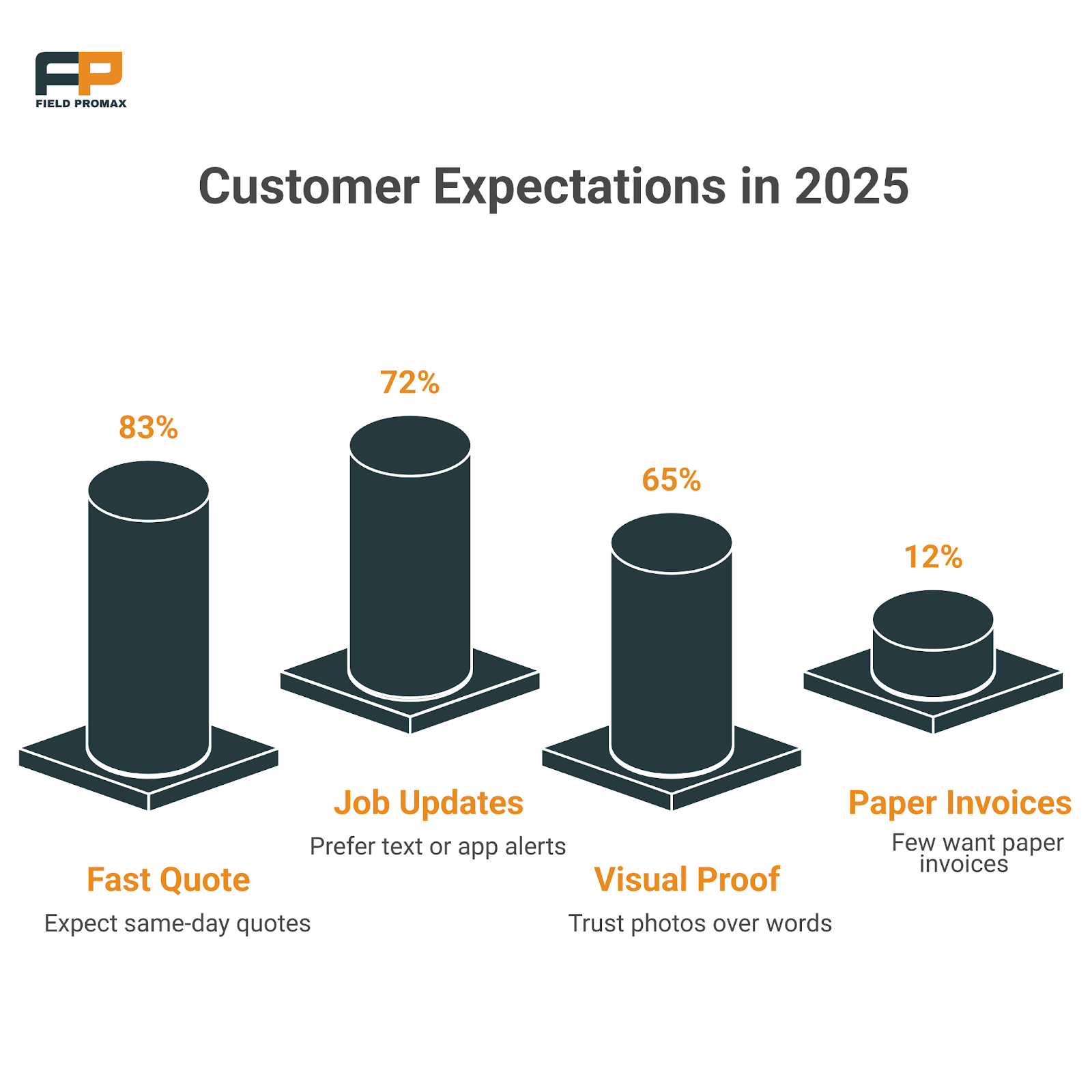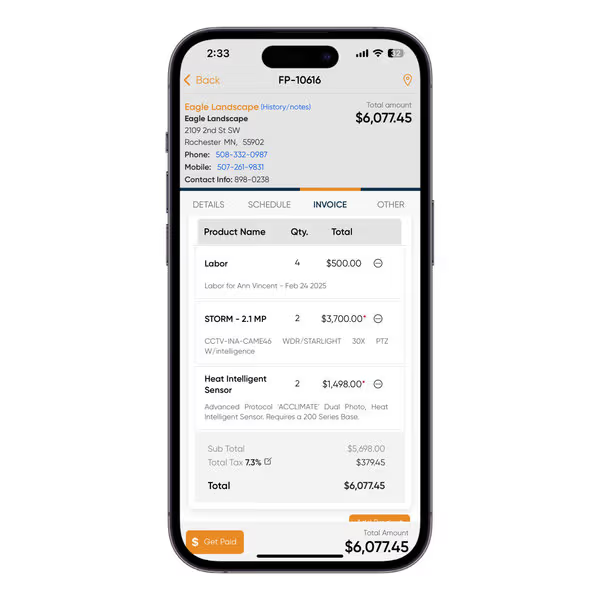It’s 7:42 a.m. You’ve already had two calls, one job reschedule, and your crew lead is texting about a panel diagram he swears was “in the truck.” The day hasn’t started, and you’re already behind.
That’s how a lot of electrical contractors operate – reactive, stretched, and juggling too many moving parts. Not because they want to. Because their systems are stuck a decade behind.
In 2025, that doesn’t work anymore.
So What’s Different Now?
Let’s start with the obvious: customers don’t wait. Not for quotes, not for callbacks, not for “I’ll get back to you.” If you’re still handwriting notes or relying on memory, you’re making it harder than it needs to be.
Beyond that?
- Inspectors want digital records
- Your team needs real-time info, not guesswork
- Job costing can’t live in your head
- Paper logs get lost or ignored
And it’s not just big shops feeling this. Even two-person crews are noticing that things move too fast to manage without the right tech.
Why Paper Just Slows You Down
Let’s be blunt, paper doesn’t show up when a customer asks for an old estimate. It doesn’t sync routes or remind your tech to grab photos before they drive off. And it sure doesn’t send an invoice before the customer forgets what they agreed to.
Most guys don’t resist tech because it’s hard. They just think it’s overkill. But once it’s in place, it’s usually the opposite. Fewer calls, fewer mistakes, fewer surprises.
What Electrical Contractors Actually Struggle With
You’re probably not fighting the jobs – you’re fighting the in-between stuff:
- Finding time to reschedule a missed appointment
- Tracking which tech did what on a job
- Sending out an invoice while you’re still on site
- Pulling up the last job photo when a client has a question
All of these add up. That’s where the right digital tools step in.
Tools That Actually Help, Not Hinder
You don’t need bells and whistles. You need a system that keeps things clear, fast, and accessible.
Let’s break it down:
1. Real Job Scheduling (Not Just a Calendar)
Drag-and-drop tools like Field Promax’s job scheduler let you assign, move, or repeat jobs without chaos. No more five calls to confirm. One update, and your whole team sees it.
2. Clean Digital Estimates
Quoting by text or over the phone leads to confusion. With a digital estimate, you send a professional doc, photos, pricing, and a “tap to approve” button. That’s it. They get it in minutes. You stop chasing them for approval.
3. Job Notes That Don’t Disappear
A lot of problems happen because someone forgot to write something down. With digital work orders, techs can snap photos, drop comments, and mark checklists while on the job. Everything’s stored under that customer’s file, no paperwork needed.
4. Invoices That Go Out Same Day
Letting invoices pile up means late payments and forgotten charges. With digital invoicing built into your field app, techs can send out the invoice before leaving the driveway. And with Xero integration, it’s synced straight into your books.
5. Accountability Without Hovering
You shouldn’t need to chase your team. Tools with GPS tagging, timestamped logs, and daily checklists help techs stay on track, without you calling to ask, “Did you fill that out?”
What Happens When You Switch
Most contractors who make the switch say some version of: “I thought it would be harder.”
Turns out, the learning curve isn’t as steep as expected. The app walks them through jobs. They stop forgetting things. You stop wondering where everyone is.
And soon, your day shifts from putting out fires to actually running the business.
You’ll notice:
- More jobs finished on time
- Fewer missed steps
- Less back-and-forth between office and crew
- Faster payments
- Happier clients who leave reviews (because now they’re getting updates)
Is It Worth It?
Let’s do basic math. If a tech forgets to invoice one job per week, that’s $1,200/month slipping through the cracks. Add in time spent rescheduling, delays from unclear notes, and hours lost looking for info and you’re talking thousands per month.
Digital tools don’t just help. They protect your bottom line.
What to Look for in a Field Tool
There are dozens of options out there. Here’s what makes one worth your time:
- Field-first design – Not built for office admins
- Simple mobile interface – Because no one wants to tap through 10 menus
- Workflows you can customize – Every crew is different
- Actual customer support – Not just an FAQ section
- One place for everything – Not five different apps that don’t talk
Field Promax is one of the few platforms built with electrical contractors in mind, not just generic service companies.
Don’t Wait for the “Perfect Time”
If you’re waiting for the perfect week to switch systems, here’s a reality check: it won’t come. You’ll always be busy. Always have projects running. That’s the point.
What better time to see if a tool holds up under pressure?
Because if it makes your life easier during your busiest stretch, that’s how you know it’s a keeper.
Bottom line: In 2025, paperwork won’t help you win jobs. Speed, clarity, and trust will. And trust starts when your clients see you’ve got your act together – quotes ready, invoices sent, updates on time.
You don’t need more effort. You need better tools.
Let’s make 2025 the year you stop chasing the chaos and start owning your workday.
Author Bio – I’m Bhargavi Halthore, and I’ve spent the last six years diving deep into the world of digital marketing and tech. Working closely with startups and tech wizards alike has kept me entertained. What excites me most is watching how software can completely transform a business! Breaking down complex technological concepts so everyone understands them is my specialty. When not exploring these latest business software trends I can usually be found sharing what I have learned at events around America or Canada.

Peyman Khosravani is a global blockchain and digital transformation expert with a passion for marketing, futuristic ideas, analytics insights, startup businesses, and effective communications. He has extensive experience in blockchain and DeFi projects and is committed to using technology to bring justice and fairness to society and promote freedom. Peyman has worked with international organizations to improve digital transformation strategies and data-gathering strategies that help identify customer touchpoints and sources of data that tell the story of what is happening. With his expertise in blockchain, digital transformation, marketing, analytics insights, startup businesses, and effective communications, Peyman is dedicated to helping businesses succeed in the digital age. He believes that technology can be used as a tool for positive change in the world.













